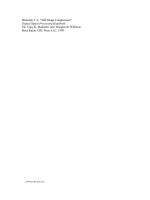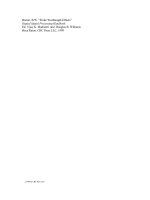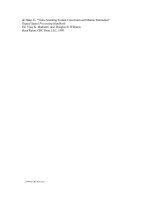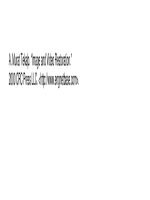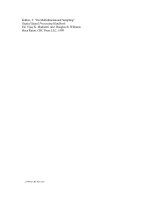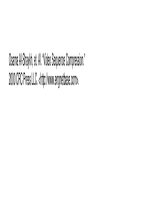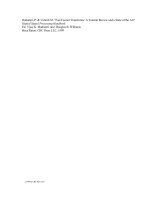Digital Signal Processing Handbook P5
Bạn đang xem bản rút gọn của tài liệu. Xem và tải ngay bản đầy đủ của tài liệu tại đây (277.77 KB, 16 trang )
Kosonocky, S. & Xiao, P. “Analog-to-Digital Conversion Architectures”
Digital Signal Processing Handbook
Ed. Vijay K. Madisetti and Douglas B. Williams
Boca Raton: CRC Press LLC, 1999
c
1999byCRCPressLLC
5
Analog-to-Digital Conversion
Architectures
Stephen Kosonocky
IBM Corporation
T.J. Watson Research Center
Peter Xiao
NeoParadigm Labs, Inc.
5.1 Introduction
5.2 Fundamentals of A/D and D/A Conversion
Nonideal A/D and D/A Converters
5.3 Digital-to-Analog Converter Architecture
5.4 Analog-to-Digital Converter Architectures
Flash A/D
•
Successive Approximation A/D Converter
•
Pipelined A/D Converter
•
Cyclic A/D Converter
5.5 Delta-Sigma Oversampling Converter
Delta-Sigma A/D Converter Architecture
References
5.1 Introduction
Digital signal processing methods fundamentally require that signals are quantized at discrete time
instancesand represented as a sequenceofwordsconsistingof 1’s and 0’s. Innature, signals areusually
nonquantizedand continuously varied with time. Natural signals such as air pressurewaves as a result
of speech are converted by a transducer to a proportional analog electrical signal. Consequently, it
is necessary to perform a conversion of the analog electrical signal to a digital representation or vice
versa if an analog output is desired. The number of quantization levels used to represent the analog
signal and the rate at which it is sampled is a function of the desired accuracy, bandwidth that is
required, and the cost of the system. Figure 5.1 shows the basic elements of a digital signal processing
system. The analog signal is first converted to a discrete time signal by a sample and hold circuit. The
FIGURE 5.1: Digital signal processing system.
output of the sample and hold is then applied to an analog-to-digital converter (A/D) circuit where
the sampled analog signal is converted to a digitally coded signal. The digital signal is then applied to
c
1999 by CRC Press LLC
the digital signal processing(DSP) system where the desired DSP algorithm is performed. Depending
on the application, the output of the DSP system can be used directly in digital form or converted
back to an analog signal by a digital-to-analog converter (D/A). A digital filtering application may
produce an analog signal as its output, whereas a speech recognition system may pass the digital
output of the DSP system to a computer system for further processing. This section will describe
basic converter terminology and a sample of common architectures for both conventional Nyquist
rate converters and oversampled delta-sigma converters.
5.2 Fundamentals of A/D and D/A Conversion
The analog signal can be given as either a voltage signal or current signal, depending on the signal
source. Figure 5.2 shows the ideal transfer characteristics for a 3-bit A/D conversion. The output of
FIGURE 5.2: Ideal transfer characteristics for an A/D converter.
theconverterisann-bit digital code given as,
D =
A
sig
FS
=
b
n
2
n
+
b
n−1
2
n−1
+ ...+
b
1
2
1
(5.1)
where A
sig
is the analog signal, FS is the analog full scale level, and b
n
is a digital value of either
0 or 1. As shown in the figure, each digital code represents a quantized analog level. The width
of the quantized region is one least-significant bit (LSB) and the ideal response line passes through
the center of each quantized region. The converse D/A operation can be represented as viewing the
digital code in Fig. 5.2 as the input and the analog signal as the output. An n-bit D/A converter
transfer equation is given as
A
sig
= FS
b
n
2
n
+
b
n−1
2
n−1
+ ...+
b
1
2
1
(5.2)
where A
sig
is the analog output signal, FS is the analog full scale level and b
n
is a binary coefficient.
The resolution of a converter is defined as the smallest distinct change that can be resolved (pro-
c
1999 by CRC Press LLC
duced) at an analog input (output) for an A/D (D/A) converter. This can be expressed as
A
sig
=
FS
2
N
(5.3)
where A
sig
is the smallest reproducible analog signal for an N-bit converter with full scale analog
signal of FS.
Theaccuracyof a converter, often referred toalso as relative accuracy, isthe worst-case error between
the actual and the ideal converter output after gain and offset errors are removed [1]. This can be
quantified as the number of equivalent bits of resolution or as a fraction of an LSB.
The conversion rate specifies the rate at which a digital code (analog signal) can be accurately
converted into an analog signal (digital code). Accuracy is often expressed as a function of conversion
rate and the two are closely linked. The conversion rate is often an underlying factor in choosing the
converter architecture. The speed and accuracy of analog components are a limiting factor. Sensitive
analog operations can either be done in parallel, at the expense of accuracy, or cyclicly reused to allow
high accuracy with lower conversion speeds.
5.2.1 Nonideal A/D and D/A Converters
Actual A/D and D/A converters exhibit deviations from the ideal characteristics shown in Fig. 5.2.
Integration of a complete converter on a single monolithic circuit or as a macro within a very large
scale integration (VLSI) DSP system presents formidable design challenges. Converter architectures
and design trade-offs are most often dictated by the fabrication process and available device types.
Device parameters such as voltage threshold, physical dimensions, etc. vary across a semiconductor
die. These variations can manifest themselves into errors. The following terms are used to describe
converter nonideal behavior:
1. Offset error, described in Fig. 5.3, is a d.c. error between the actual response with the ideal
response. This can usually be removed by trimming techniques.
FIGURE 5.3: Offset error.
2. Gain error is defined as an error in the slope of the transfer characteristic shown in Fig. 5.4,
which can also usually be removed by trimming techniques.
c
1999 by CRC Press LLC
FIGURE 5.4: Gain error.
3. Integral nonlinearity is the measure of worst-case deviation from an ideal line drawn
between the full scale analog signal and zero. This is shown in Fig. 5.5 as a monotonic
nonlinearity.
FIGURE 5.5: Monotonic nonlinearity.
4. Differential nonlinearity is the measure of nonuniform step sizes between adjacent steps
in a converter. This is usually specified as a fraction of an LSB.
5. Monotonicity in a converterspecifies that the output will increasewith an increasinginput.
Certain converterarchitectures can guarantee monotonicity for a specified number of bits
of resolution. A nonmonotonic transfer characteristic is detailed in Fig. 5.6.
6. Settling time for D/A converters refers to the time taken from a change of the digital code
to the point at which the analog output settles within some tolerance around the final
value.
c
1999 by CRC Press LLC
FIGURE 5.6: Nonmonotonic nonlinearity.
7. Glitches can occur during changes in the output at major transitions, i.e., at 1 MSB, 1/2
MSB, 1/4 MSB. During large changes, switching time delays between internal signal paths
can cause a spike in the output.
The choice of converter architecture can greatly affect the relative weight of each of these errors.
Data converters are often designed for low cost implementation in standard digital processes, i.e.,
digital CMOS, which often do not have well-controlled resistors or capacitors. Absolute values of
these devices can vary by as much as ± 20% under typical process tolerances. Post-fabrication
trimming techniques can be used to compensate for process variations, but at the expense of added
cost and complexity to the manufacturing process. Aswill be shown, various architectural techniques
can be used to allow high speed or highly accurate data conversion with such variations of process
parameters.
5.3 Digital-to-Analog Converter Architecture
The digital-to-analog (D/A) converter, also known as a DAC, decodes a digital word into a discrete
analog level. Depending on the application, this can be either a voltage or current. Figure 5.7 shows
a high level block diagram of a D/A converter. A binary word is latched and decoded and drives a set
of switches that control a scaling network. A basic analog scaling network can be based on voltage
scaling, current scaling, or charge scaling [1, 2]. The scaling network scales the appropriate analog
level from the analog reference circuit and applies it to the output driver. A simple serial string of
identical resistors between a reference voltage and ground can be used as a voltage scaling network.
Switches can be used to tap voltages off the resistors and apply them to the output driver. Current
scaling approaches are based on switched scaled current sources. Charge scaling is achieved by
applying a reference voltage to a capacitor divider using scaled capacitors where the total capacitance
value is determined by the digital code [1]. Choice of the architecture depends on the available
components in the target technology, conversion rate, and resolution. Detailed description of these
trade-offs and designs can be found in the references [1]–[5].
c
1999 by CRC Press LLC
